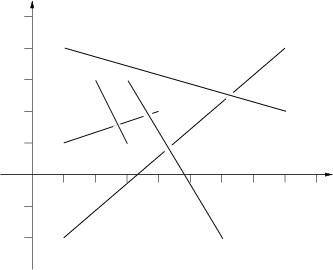Pick-up sticks
| Time Limit: 3000MS |
|
Memory Limit: 65536K |
| Total Submissions: 4189 |
|
Accepted: 1501 |
Description
Stan has n sticks of various length. He throws them one at a time on the floor in a random way. After finishing throwing, Stan tries to find the top sticks, that is these sticks such that there is no stick on top of them. Stan has noticed that the last thrown stick is always on top but he wants to know all the sticks that are on top. Stan sticks are very, very thin such that their thickness can be neglected.

Input
Input consists of a number of cases. The data for each case start with 1 <= n <= 100000, the number of sticks for this case. The following n lines contain four numbers each, these numbers are the planar coordinates of the endpoints of one stick. The sticks are listed in the order in which Stan has thrown them. You may assume that there are no more than 1000 top sticks. The input is ended by the case with n=0. This case should not be processed.
Output
For each input case, print one line of output listing the top sticks in the format given in the sample. The top sticks should be listed in order in which they were thrown.
The picture to the right below illustrates the first case from input.
Sample Input
5
1 1 4 2
2 3 3 1
1 -2.0 8 4
1 4 8 2
3 3 6 -2.0
3
0 0 1 1
1 0 2 1
2 0 3 1
0
Sample Output
Top sticks: 2, 4, 5.
Top sticks: 1, 2, 3.
Hint
Huge input,scanf is recommended.

 /**//***********************************
/**//***********************************
 暴力就行,从第一个开始判断
暴力就行,从第一个开始判断
 如果两条线段相交就把前面一条筛选掉
如果两条线段相交就把前面一条筛选掉
 判断线段相交直接贴的吉大模板。。。
判断线段相交直接贴的吉大模板。。。
 ***********************************/
***********************************/
 #include <iostream>
#include <iostream>
 #include <cstdio>
#include <cstdio>
 #include <cstring>
#include <cstring>

 using namespace std;
using namespace std;

 const int maxn = 100000 + 5;
const int maxn = 100000 + 5;
 const double eps=1e-10;
const double eps=1e-10;


 struct point
struct point  { double x, y; };
{ double x, y; };

 point p[maxn], b[maxn];
point p[maxn], b[maxn];
 bool ans[maxn];
bool ans[maxn];


 double min(double a, double b)
double min(double a, double b)  { return a < b ? a : b; }
{ return a < b ? a : b; }


 double max(double a, double b)
double max(double a, double b)  { return a > b ? a : b; }
{ return a > b ? a : b; }

 bool inter(point a, point b, point c, point d)
bool inter(point a, point b, point c, point d)


 {
{
 if( min(a.x, b.x) > max(c.x, d.x) ||
if( min(a.x, b.x) > max(c.x, d.x) ||
 min(a.y, b.y) > max(c.y, d.y) ||
min(a.y, b.y) > max(c.y, d.y) ||
 min(c.x, d.x) > max(a.x, b.x) ||
min(c.x, d.x) > max(a.x, b.x) ||
 min(c.y, d.y) > max(a.y, b.y) )
min(c.y, d.y) > max(a.y, b.y) )
 return 0;
return 0;

 double h, i, j, k;
double h, i, j, k;

 h = (b.x - a.x) * (c.y - a.y) - (b.y - a.y) * (c.x - a.x);
h = (b.x - a.x) * (c.y - a.y) - (b.y - a.y) * (c.x - a.x);
 i = (b.x - a.x) * (d.y - a.y) - (b.y - a.y) * (d.x - a.x);
i = (b.x - a.x) * (d.y - a.y) - (b.y - a.y) * (d.x - a.x);
 j = (d.x - c.x) * (a.y - c.y) - (d.y - c.y) * (a.x - c.x);
j = (d.x - c.x) * (a.y - c.y) - (d.y - c.y) * (a.x - c.x);
 k = (d.x - c.x) * (b.y - c.y) - (d.y - c.y) * (b.x - c.x);
k = (d.x - c.x) * (b.y - c.y) - (d.y - c.y) * (b.x - c.x);

 return h * i <= eps && j * k <= eps;
return h * i <= eps && j * k <= eps;
 }
}

 int main()
int main()


 {
{
 int n;
int n;
 int res[maxn];
int res[maxn];
 while( cin >> n, n )
while( cin >> n, n )


 {
{
 memset( ans, 0, sizeof( ans ) );
memset( ans, 0, sizeof( ans ) );
 for( int i = 0; i < n; i++ )
for( int i = 0; i < n; i++ )


 {
{
 cin >> p[i].x >> p[i].y >> b[i].x >> b[i].y;
cin >> p[i].x >> p[i].y >> b[i].x >> b[i].y;
 }
}

 for( int i = 0; i < n; i++ )
for( int i = 0; i < n; i++ )


 {
{
 for( int j = i + 1; j < n; j++ )
for( int j = i + 1; j < n; j++ )


 {
{
 if( inter(p[i], b[i], p[j], b[j] ) )
if( inter(p[i], b[i], p[j], b[j] ) )


 {
{
 ans[i] = 1;
ans[i] = 1;
 break; //不加break会超时。。。
break; //不加break会超时。。。
 }
}
 }
}
 }
}
 int ct = 0;
int ct = 0;
 cout << "Top sticks: ";
cout << "Top sticks: ";
 for( int i = 0; i < n; i++ )
for( int i = 0; i < n; i++ )
 if( !ans[i] ) res[ct++] = i + 1;
if( !ans[i] ) res[ct++] = i + 1;
 for( int i = 0; i < ct - 1; i++ )
for( int i = 0; i < ct - 1; i++ )
 cout << res[i] << ", ";
cout << res[i] << ", ";
 cout << res[ct-1] << "." << endl;
cout << res[ct-1] << "." << endl;
 }
}
 return 0;
return 0;
 }
}

posted on 2010-10-03 16:21
Vontroy 阅读(652)
评论(0) 编辑 收藏 引用 所属分类:
计算几何 、
POJ